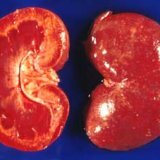Interstitial nephritis, symptoms

Interstitial nephritis( IN) is a renal inflammatory disease of the abacterial( noninfectious) nature with the localization of pathology in the interstitial( interstitial) tissue and damage to the tubular nephron apparatus. This nosological form of the disease is independent. In comparison with pyelonephritis, in which case there is also a lesion of interstitial tissue and renal tubules, interstitial nephritis does not have destructive changes in kidney tissues, and the inflammatory process rarely extends to pelvic and cups. The disease is not yet very well known to practicing doctors.
Interstitial nephritis.
Clinical diagnosis of interstitial nephritis is difficult even in special institutions of nephrological orientation due to the absence of characteristic pathognomonic laboratory and clinical criteria only for it, and also because of its similarity with other forms of nephropathy. For this reason, the most reliable and convincing way to establish the diagnosis of IN at this time can be considered a puncture kidney biopsy. Due to the fact that in the conditions of clinical practice the diagnosis of IN is still not enough often, then to this day there are no exact data on the incidence of the disease. However, according to the information available in the literature, over the past decades, there has been a marked upward trend in the incidence of this disease in adults. This is associated not only with the fact that the methods of diagnosing IN are improving, but also with the most extensive influence on the kidneys of the factors that cause its appearance( especially medicines).
There are interstitial acute nephritis( SPI), as well as chronic( HIN), and in addition secondary and primary. For the reason that in this disease pathology always includes not only interstitial tissue, but also tubules, then the term "tubulointerstitial nephritis" is qualified to use the term "interstitial nephritis".The development of the primary IN occurs without any previous damage( disease) of the kidneys. The secondary form of IN often complicates the course of a pre-existing kidney disease or diseases such as myeloma, diabetes mellitus, leukemia, gout, vascular kidney lesions, oxalate nephropathy, hypercalcemia, etc.
Symptoms of the disease.
Acute form of interstitial nephritis( SPE) is formed at different ages, also in the elderly and in infants, but is most prevalent at the age of 20-50 years. The nature and complexity of the clinical manifestations of the disease depends on how the general intoxication of the organism is expressed, and also on the level of activity of pathology in the kidney area. If we talk about the first symptoms, nephritis often manifests itself 2-3 days after the start of antibiotic therapy( often with penicillin or its semi-synthetic prototypes) along the geodyne of exacerbation of tonsillitis, chronic tonsillitis, otitis, SARS, sinusitis and other diseases that precede the growth of SPE.In other situations, they form a few days after the appointment of anti-inflammatory non-steroid drugs, cytostatics, diuretics, the introduction of radiopaque components, vaccines, serums. Most patients have complaints about sweating, weakness, headaches, aching pain in the lumbar region, drowsiness, falling or loss of appetite, nausea.
Often mentioned symptoms are accompanied by chills and fever, muscle aches, often polyarthralgia, allergic inflammations on the skin. In other situations, moderately expressed and non-prolonged arterial hypertension may develop. For SPE is not characterized by puffiness and, more often than not, they are not. It is also rare to observe dysuric phenomena. In the overwhelming majority of situations from the first day, polyuria with a relative low urinary density( hypostenuria) is noted. Only in case of very severe therapy of SPE at the very beginning of the disease, one can observe a significant decrease( oliguria) of urine until the anuria begins to develop( which is combined with hypostenuria) and other signs of arthritis. At the same time, urinary syndrome is also detected: insignificant( 0.033-0.33 g / l) or( less often) moderately manifested( about 1.0 to 3.0 g / l) proteinuria, insignificant or moderate leukocyturia, microhematuria, cylindruriaWith a predominant amount of hyaline, and in case of severe leakage - and the manifestation of waxy and granular cylinders. Calcium and oxalaturia are often found.
The origin of proteinuria is mainly associated with a decrease in protein reabsorption with the help of the epithelium of the proximal channels, but the possibility of secretion of a specific Tamm-Horsfall protein protein into the lumen created by the tubules is not ruled out.
Interstitial nephritis, the symptoms of which may be different. The mechanism of formation of microhematuria is also not entirely clear.
Painful changes in urine remain throughout the disease( for 2-4-8 weeks).Especially long( about 2-3 months and more) are hypostenuria and polyuria. Occasionally observed on the first day of the disease, oliguria is associated with an increase in intra-capsular and intra-canal pressure, which causes a drop in the effective filtration pressure and a drop in the glomerular filtration rate. Together with the drop in the concentration capacity, the disturbance of the function of the release of nitrogen by the kidneys( especially in difficult situations) begins to increase in the first day, which may be manifested by hypera-isotomy or an increase in the level of creatinine and urea in the blood. Probably also an electrolyte balance disorder( hyponatremia, hypokalemia, hypochloraemia), as well as acid-base balance with acidosis. The severity of these renal impairments in regulating the balance of nitrogen, alkaline-acid equilibrium, and water-electrolyte homeostasis depends on the severity of the disease in the kidney region and reaches its maximum level with the development of acute renal failure.



